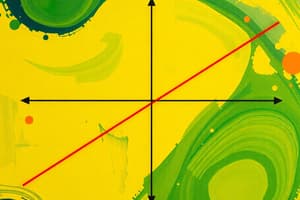Podcast
Questions and Answers
What is a fixed input?
What is a fixed input?
- An input that depends on the quantity of output produced
- An input whose quantity can be varied at any time
- An input whose quantity is fixed for a period and cannot be varied (correct)
- An input that is not related to the production process
In the long run, what can be varied?
In the long run, what can be varied?
- Fixed inputs only
- All inputs (correct)
- Variable inputs only
- At least one input
What does the total product curve show?
What does the total product curve show?
- The relationship between fixed cost and variable cost
- How the quantity of output depends on the quantity of the fixed input for a given quantity of the variable input
- The relationship between total cost and quantity of output
- How the quantity of output depends on the quantity of the variable input for a given quantity of the fixed input (correct)
What is marginal product?
What is marginal product?
What is a fixed cost?
What is a fixed cost?
What is the formula for marginal cost (MC)?
What is the formula for marginal cost (MC)?
Why is the marginal cost curve upward sloping?
Why is the marginal cost curve upward sloping?
What is the formula for average total cost (ATC)?
What is the formula for average total cost (ATC)?
Why is the average variable cost (AVC) upward sloping?
Why is the average variable cost (AVC) upward sloping?
Why is the average fixed cost (AFC) downward sloping?
Why is the average fixed cost (AFC) downward sloping?
What happens when the marginal cost curve intersects the average total cost curve from below?
What happens when the marginal cost curve intersects the average total cost curve from below?
In the long run, what does the long-run average total cost curve show?
In the long run, what does the long-run average total cost curve show?
When do economies of scale occur?
When do economies of scale occur?
What are marginal abatement costs used for?
What are marginal abatement costs used for?
Why does the marginal cost curve intersect the average total cost curve at its lowest point?
Why does the marginal cost curve intersect the average total cost curve at its lowest point?
What is the formula for average fixed cost (AFC)?
What is the formula for average fixed cost (AFC)?
When does economies of scale occur?
When does economies of scale occur?
What is the formula for marginal cost (MC)?
What is the formula for marginal cost (MC)?
What does the long-run average total cost curve show?
What does the long-run average total cost curve show?
What is a common measure used to examine the cost of reducing pollution emitted into the environment?
What is a common measure used to examine the cost of reducing pollution emitted into the environment?
What happens when there are decreasing returns to scale (diseconomies of scale)?
What happens when there are decreasing returns to scale (diseconomies of scale)?
In the short run, at least one input is fixed. What is the period in which all inputs can be varied?
In the short run, at least one input is fixed. What is the period in which all inputs can be varied?
What is the relationship between the quantity of inputs a firm uses and the quantity of output it produces called?
What is the relationship between the quantity of inputs a firm uses and the quantity of output it produces called?
What is a fixed input?
What is a fixed input?
What does the total product curve show?
What does the total product curve show?
$Marginal product$ measures what?
$Marginal product$ measures what?
What is a fixed cost?
What is a fixed cost?
What is the total cost (TC) of producing a given quantity of output?
What is the total cost (TC) of producing a given quantity of output?
Why does marginal product initially rise as more workers are hired?
Why does marginal product initially rise as more workers are hired?
What does a variable cost depend on?
What does a variable cost depend on?
In which period can all inputs be varied?
In which period can all inputs be varied?
What happens when marginal cost intersects average total cost from below?
What happens when marginal cost intersects average total cost from below?
Why is average variable cost (AVC) upward sloping?
Why is average variable cost (AVC) upward sloping?
What is the relationship between the quantity of inputs a firm uses and the quantity of output it produces called?
What is the relationship between the quantity of inputs a firm uses and the quantity of output it produces called?
In the long run, what can be varied?
In the long run, what can be varied?
What does the total product curve show?
What does the total product curve show?
Why does marginal product initially rise as more workers are hired?
Why does marginal product initially rise as more workers are hired?
$Marginal product$ measures what?
$Marginal product$ measures what?
$Marginal product$ initially rises as more workers are hired, then it declines. What is this an example of?
$Marginal product$ initially rises as more workers are hired, then it declines. What is this an example of?
$Marginal cost$ measures what?
$Marginal cost$ measures what?
What is a fixed cost?
What is a fixed cost?
What is a variable cost?
What is a variable cost?
Why does the marginal cost curve intersect the average total cost curve at its lowest point?
Why does the marginal cost curve intersect the average total cost curve at its lowest point?
What is the formula for marginal cost (MC)?
What is the formula for marginal cost (MC)?
When do economies of scale occur?
When do economies of scale occur?
What does the total product curve show?
What does the total product curve show?
Why is the average fixed cost (AFC) downward sloping?
Why is the average fixed cost (AFC) downward sloping?
What is a common measure used to examine the cost of reducing pollution emitted into the environment?
What is a common measure used to examine the cost of reducing pollution emitted into the environment?
Flashcards are hidden until you start studying
Study Notes
Fixed Inputs and Costs
- Fixed input: Resources that remain constant regardless of production levels in the short run.
- Fixed cost: Expenses that do not change with the level of output, such as rent or salaries.
Variable Inputs and Costs
- In the long run, all inputs can be varied, allowing firms to optimize production.
- Variable cost: Costs that change with the level of output, such as materials and labor.
Total Product Curve
- The total product curve illustrates the relationship between the quantity of inputs used and the quantity of output produced.
- It shows how output increases as more variable inputs are added to fixed inputs.
Marginal Product and Costs
- Marginal product: The additional output generated by adding one more unit of a variable input.
- Marginal cost (MC): The change in total cost that arises when the quantity produced changes by one unit, often calculated as ΔTC/ΔQ.
- The marginal cost curve typically slopes upward due to the law of diminishing returns, where increasing variable inputs leads to less additional output.
Average Costs
- Average total cost (ATC): Calculated as total costs divided by the quantity of output (ATC = TC/Q).
- Average variable cost (AVC): Generally slopes upward as output increases because variable costs increase with production.
- Average fixed cost (AFC): Decreases as output increases because fixed costs are spread over more units.
Cost Curve Intersections
- When the marginal cost curve intersects the average total cost curve from below, it indicates that ATC is at its minimum, as MC is low enough to reduce the average cost.
- The relationship of marginal cost intersecting average cost curves is fundamental in determining optimal production levels.
Long-Run Average Cost Curve
- The long-run average total cost curve shows the lowest possible cost of production for any output level when all inputs are variable.
- Economies of scale occur when increasing production leads to lower average costs due to factors like operational efficiencies.
Pollution and Costs
- Marginal abatement costs: Used to measure the cost of reducing pollution levels, guiding environmental policies.
- A common measure for pollution costs relates to the marginal cost of abatement, linking economic activity with environmental impact.
Returns to Scale
- Decreasing returns to scale (diseconomies of scale): Occur when increasing inputs results in a less-than-proportional increase in output, leading to higher average costs.
- The transition period in which all inputs can be varied is termed the long-run, contrasting with the short run where at least one input is fixed.
Summary of Relationships
- The relationship between inputs and outputs is defined as production function, determining the efficiency of resource allocation.
- Marginal product typically initially rises with additional workers due to increased efficiency, then declines due to diminishing marginal returns.
Studying That Suits You
Use AI to generate personalized quizzes and flashcards to suit your learning preferences.




